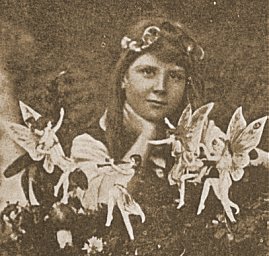
|
The Coming of the Fairiesby Arthur Conan Doyle[1922] |

|
The Coming of the Fairiesby Arthur Conan Doyle[1922] |
Arthur Conan Doyle, the creator of Sherlock Holmes, in his later years became attracted to spiritualism and occult topics. This was after the death of his son Raymond during World War I. While researching the topic of fairies, some photographs from a working-class family in rural Yorkshire were brought to Doyle's attention by a Theosophist friend. These photographs appeared to show diminutive fairies cavorting in the presence of humans, specifically two teenage girls, Elsie and Frances. They had taken the photographs by themselves, and there were no overt signs that the negatives had been tampered with. Doyle championed the photographs, and in the process destroyed his reputation; which is probably why this book, out of all of the Doyle corpus, has not been put into etext until now. The Coming of the Fairies was possibly a bigger disappointment for Doyle fans than when he killed off Sherlock Holmes.
These photographs, which caused a sensation at the time, are easily recognizable as blatant fakes by modern eyes, sensitized to seeing much more photorealistic computer-generated elves and fairies. The fairies are statically posed, and are neatly coiffed and dressed in period clothing, hardly what one would expect from wild nature-elementals. They are just too flat-looking and high contrast to be anything other than cardboard cutouts positioned in the scene, and could be constructed by adolescent girls with artistic leanings. And indeed, many years later the pair did admit that they had faked the photos.
However, even a skeptic will have to admit that just because these photos are fake, it does not logically imply there are no such beings. Just because some UFO photos are fake, doesn't mean that there are no UFOs! But 'extraordinary claims demand extraordinary proof'. While we may not have extraordinary proof of fairies, there is more to the phenomena than meets the eye. Enough data that some explanation must be attempted. Doyle barely scratches the surface of the massive literature on fairies here; for a comprehensive survey, for instance, refer to Evan-Wentz' The Fairy Faith in Celtic Countries. The real reason that this charming little book is of interest today is historical, and of course, because of the author.
| Главная | Попытка (сказки) |